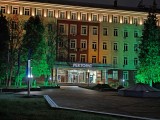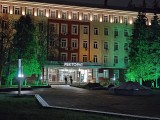Motorola Edge 40 Pro review

The 2x50MP setup from the 30 Pro enhanced by a 12MP zoom
The Edge 40 Pro has a triple camera setup on its back that borrows bits from the 30 Pro and Ultra models. The 50MP main camera comes from last year's Pro; the 50MP ultrawide is shared across all three, while the 12MP telephoto is inherited from the Ultra.

The primary camera uses an OmniVision sensor, and it's the same OV50A that the 30 Pro featured - that is to say, it's not just that the resolution numbers are the same, but it's the exact same sensor. It has a 1/1.55" optical format, so it's fairly large. Individual pixel size is 1.0µm, and since it's a 4-cell design (OV's nomenclature for what Sony calls Quad Bayer and Samsung - Tetrapixel), you're effectively getting 4-to-1 binned 12.5MP images with 2.0µm pixels - that last number is stamped on the back of the phone next to the cameras.
The sensor has 2x2 on-chip lenses and all-pixel phase detection autofocus - you can have a look at Sony's explanation for the same technology here.
The lens in front of the OV50A has an f/1.8 aperture and is stabilized.
The ultrawide camera has a lens that covers a 114-degree field of view, and has an f/2.2 aperture. It supports autofocus, which means you can use it for emphasizing nearby subjects, but also for proper closeups instead of the generally inferior dedicated 'macro' cameras. The sensor that's capturing the images is the Samsung JN1 (S5KJN1) - a Tetrapixel imager with a 1/2.76" optical format and tiny individual pixels at 0.64µm.
At the opposite end of the zoom range is the 2x telephoto, which Motorola also calls a portrait camera. The sensor here is a Sony IMX663 (1/2.93", 1.22µm), mated to a particularly bright f/1.6 aperture lens with an equivalent focal length listed at 50mm.
Over on the front, the 60MP selfie camera is also shared between the 30 Pro, 30 Ultra, and now the 40 Pro. It's based on the OmniVision OV60A sensor - 60 million 0.61µm pixels crammed into a 1/2.8" optical format imager. The 4-cell color filter means you can think of it as a 15MP sensor with 1.22µm pixels. The lens aperture is f/2.2. There's no autofocus on this camera.

The camera app on the Edge 40 Pro is developed in-house, in contrast to the otherwise stock-looking approach to software.
The basics are as usual - the camera modes are arranged in a customizable carousel formation, with the 'More' tab at the rightmost end of the carousel holding the more seldom-used shooting modes.
Pro mode gives you full control over the camera's settings like white balance, ISO, focus, shutter speed, and exposure compensation, and it works not only on the three rear cameras, but also on the front-facing one (minus the manual focusing). A tiny live histogram is provided, but there's no focus peaking or zebras.
Additional settings for each camera mode can be found by swiping down in the viewfinder. There's a tiny bar at the far end to indicate that, but if you miss it, you may be left wondering where some controls are, like the flash and self-timer settings in Photo mode, and frame rate in Video mode.
The gear icon for the general settings menu houses even more settings, though there isn't a straightforward separation of what you're going to find where. For example, the 60MP mode for selfies is found in the settings menu, while full-res capture for the rear cameras is accessed from the 'Ultra-Res' mode on the carousel. A lot of the app's peculiarities are long-standing Moto things, so you may be right at home if you're a recurring user, but that doesn't necessarily make them intuitive.
Daylight image quality
The Edge 40 Pro's daylight photos from its main camera, 12.5MP by default, are good overall, but there are a few 'buts'. For example, we're getting a fairly consistent trend for the auto white balance to produce images with a greenish tint - it's not dramatic, but it's not too pleasing either. Color saturation is on point, though, and a quick WB fix makes colors easily likable. Then there's the fairly high contrast, or rather the sharp rolloff in the shadows, that can leave them a little underdeveloped.
The amount of detail is good - it's comparable to other 12-ish megapixel photos, but it's not particularly likable when it comes to random textures like grass, which do have a fairly artificial look. Additionally, there's a certain grit to areas of uniform color that we would hesitate to call noise because of the word's negative implications, but it's not necessarily appealing either.










Daylight samples, main camera (1x), 12.5MP
The Ultra-Res 50MP mode doesn't appear to bring any meaningful advantage in resolved detail - it just makes things appear bigger.










Daylight samples, main camera (1x), 50MP
What is an unchanged zoom camera, compared to the Edge 30 Ultra, delivers largely the same results, and they're around the okay mark. Hardly a benchmark for sharpness, these are also very heavily processed - it's almost as if they've been upscaled from, say, 8MP and sharpened to try and compensate for it. Contrast is again a bit much, and while balance leans towards cool too.








Daylight samples, telephoto camera (2x)
The ultrawide doesn't achieve greatness either but sticks to that mid-tier standard. Once more, contrast is dialed pretty high - we understand the strive for pop, but there can be too much of a good thing. Detail is alright, we'd say there's a modest improvement over the Edge 30 Ultra's results - with strong sharpening applied, of course. Some graininess is present, too, appearing almost like a checkered pattern in the skies.
Naturally, the camera's ability to focus close makes it usable for a wider array of photo ops, and that's before we get to the Macro mode.












Daylight samples, ultrawide camera (0.5x), 12.5MP
We'd say that this time the 'native' resolution mode on the ultrawide camera captures just slightly better results than what we got on the Edge 30 Ultra, but that still doesn't move it into the 'useful' category.












Daylight samples, ultrawide camera (0.5x), 50MP
Closeups
The macro mode isn't a standalone mode, strictly speaking, but rather a button on the zoom selector in Photo mode. It switches to a cropped-in and upscaled view from the ultrawide camera, which matches the main camera's field of view. Overall, the results are actually pretty great when put into smartphone macro camera context - we're just not fond of that fuchsia strawberry which was very much red in real life.
Low-light image quality
As has become the norm, Edge 40 Ultra applies Night mode processing automatically if you have the 'Auto Night Vision' toggle enabled in the Photo mode settings. It was more consistent in actually applying that treatment than what we got on the Edge 30 Ultra, which is a welcome upgrade, of course. In that sense, the differences between the full Auto and the dedicated Night Vision mode are even smaller now, perhaps nonexistent.
Main camera
Either way, shooting on the main camera, you'd be getting excellent dynamic range with good shadow development and nicely contained highlights. We'd say the auto white balance deals well with street lighting, and saturation is on point.
Detail is very good, and we don't mind the graininess here - we appreciate that Motorola didn't choose noise reduction over detail. Sharpening is also applied in a rather measured way, another statement you can interpret as praise.








Low-light samples, main camera (1x), Auto Night Vision
Here is how the same scenes are rendered in the dedicated Night Vision mode. Perhaps you could spot a spotlight here or there that's been toned down a little, and maybe the absolute darkest of shadows are marginally lifted in one scene or another. The thing is, we wouldn't necessarily attribute that to the Night Vision mode - simple shot-to-shot variation of how steady the hands were of the person holding the phone is just as good an explanation. All in all, the full auto is good enough.








Low-light samples, main camera (1x), Night Vision
Now, turning off the Auto Night Vision in Photo mode does bring changes, and those are ones you'll likely not appreciate. Shadows go darker, noise reduction runs rampant, detail gets lost. Don't turn off the auto.








Low-light samples, main camera (1x), Auto Night Vision OFF
Ultrawide camera
Auto Night Vision or standalone Night Vision mode, the Edge 40 Pro's ultrawide outputs the same pictures, and while hardly class-leading, they're pretty solid pictures too. Dynamic range is great; the tonal extremes are developed well, and white balance and color saturation are on point. The detail wasn't praiseworthy during the day, but at least it doesn't suffer particularly at night, so we'd consider that a win.







Low-light samples, ultrawide camera (0.5x), Auto Night Vision
Here are the same scenes as shot in Night Vision mode.







Low-light samples, ultrawide camera (0.5x), Night Vision
Just for reference, have a look at those photos' counterparts with the Auto Night Vision turned off. Most notable are the darker, softer shadows.







Low-light samples, ultrawide camera (0.5x), Auto Night Vision OFF
Telephoto camera
Stop us if you've heard this before, but the photos taken on the zoom camera in Photo mode with Auto Night Vision enabled are the same as the ones taken in Night mode. And those are probably our favorites from the whole bunch.
There's a high level of detail and a nicely fine grain structure to the inevitably present noise that is almost appealing in and of itself - just don't go on YouTube and type 'how to make digital look like film', because you're ruining it for all of us. We're liking these better than the Edge 30 Ultra's results thanks to the improved color and dynamic range, too, not just their crispiness.






Low-light samples, telephoto camera (2x), Auto Night Vision






Low-light samples, telephoto camera (2x), Night Vision
For completeness' sake, this is how the images would look if you were to disable the Night Vision. Put simply, you shouldn't.






Low-light samples, telephoto camera (2x), Auto Night Vision OFF
Once you're done with the real world samples, head over to our Photo compare tool to see how the Motorola Edge 40 Pro stacks up against the competition.



Motorola Edge 40 Pro against the Pixel 7 Pro and the OnePlus 11 in our Photo compare tool
Portrait mode
We weren't fans of the Edge 30 Ultra's Portrait mode results, and the Edge 40 Pro doesn't really do much to change that. The trio of classic focal length emulations has been carried over - Wide (35mm) comes from the main camera, Standard (50mm) and Close up (85mm) are sourced form the zoom camera.
Detail is sketchy at all zoom levels, even in the 50mm mode, which shoots at the native magnification of the telephoto camera, though it still manages to look closest to usable. The 85mm mode is particularly bad, the 35mm is somewhere in between.
The blur levels vary depending on the zoom level chosen and are well judged here (better than on the 30 Ultra) and make for a natural background look. Subject detection is quite good, though the wood wall panelling did fool it (but only at the wide end). Now if only the subject could be rendered with better detail.




Portrait mode samples, telephoto camera (50mm)




Portrait mode samples, main camera (35mm)




Portrait mode samples, telephoto camera (85mm)
Selfies
The Edge 40 Pro captures 15MP selfies by default, though the option for native 60MP resolution shooting is also there (buried in the menu and perhaps rightly so). The default images are mostly great - we're getting excellent detail levels, pleasing skin tones, and wide dynamic range. In the 'not so good' list is the slightly off white balance in some scenes.
Reader comments
- Hivem
- 23 Oct 2024
- JBd
I just ordered mine, it cost me $190 American version, it has 5100mah battery but 8GB ram, does it really not last long enough!
- dejan90to
- 10 Sep 2024
- 3nq
This phone is perfect. You are talking siht. Battery lasts over 12 hours, and I'm using it very heavy
- Anonymous
- 10 Jun 2024
- CbD
Thanks for the heads up, but the Battery life results here are big? Maybe it's something else you got on the phone that eats battery? Or maybe the Update nuked it. I'm getting really wary of any Android version updates, on most phones i see...

















